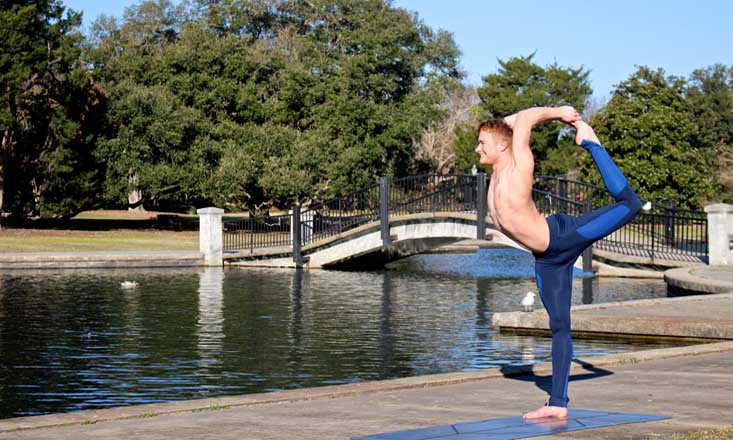Early on in my yoga practice, and eventually in my teaching, I, like many other students, began to recognize a lack of symmetrical ability in my body. I knew I was right-handed; I had always been stronger there.
But why is my right hamstring region so much more flexible? Why can I stand for much longer sequences on my right leg than on my left? These things frustrated me—while I felt harmony with my right side, the entire left-side of my body felt like it belonged to someone else, beyond my control.
As time passed and I paid closer attention, I began to notice patterns in my own practice, my teaching, and the teaching of other instructors. Because of this, I changed my ways.
I’ve been told that one of the aspects of my teaching style is a little—strange—at first, but that my students grow to love it, understand it, and appreciate it. Can you take a guess as to what it might be?
I always teach the left side first.
I teach the left side of every sequence first, and for several reasons. It’s changed my practice and the practices of my students who practice with me regularly. Before you freak out about breaking tradition, let me explain why I do this.
1. It gets the students to tune in.
Because most instructors teach the right side first, students are so prepared to fly the right leg from Down Dog. By cueing left leg or initiating the left side first, students often times lift the right leg, realize what has happened, and then switch to get back on track.
This nudges the students toward active listening. It also gets them out of autopilot, out of their heads, and drops them back into their bodies and the present moment.
2. Time is of the essence.
Most Vinyasa Flow teachers, no matter how seasoned, tend to hold the first side longer.
Unless you’re practicing Ashtanga (where poses are held for five breaths), or the instructor is using a stopwatch (like in Yin), you’ve probably noticed it while taking other’s classes. If you’re an instructor, did you know that you probably do it too?
I find that this is mainly because:
- Teachers like to talk, and
- Teachers like to demo.
So we talk a lot on the first side about alignment and positioning, how the pose should feel, what the students ought to be thinking about and doing in the pose, etc. We also like to demo how the students are going to transition and what the pose should look like.
By the time we get to the next side, we don’t have as much to say and the students know what to expect, so we don’t demo. We cue the pose, set them up, then move them along to the next pose, not even realizing we were still talking at this point on the other side.
Side note (and another reason why I switched it up): Because we tend to demo so much on the first side, I noticed that my own right side was getting much more stronger and flexible. After all, it was more likely to be in those poses throughout the day.
When I first started teaching, I taught between three and seven public classes and private clients per day, from sun up until midnight. I would demo on the right side, and be more likely to walk around and adjust or assist on the left side. My right side was cooked.
3. An elephant never…Wait, what’s the saying again?
Many instructors forget poses and transitions on the second side. We’ve all been there.
But since many yogis who practice regularly already have overdeveloped right side practices as they spend more time on that side, we’re doing a disservice to the balance of the body by overworking the right side, spending less time on the left, and forgetting poses and transitions that we did on the right.
4. We need to counter muscle fatigue and mental exhaustion.
When we teach powerful classes, heated classes, and/or long sequences, the first side is primed and ready for the task at hand. But by the end of the sequence or class, it starts to get tired and fatigued.
By the time we move along to the second side (which is already feeling neglected because of the tendencies toward shorter timing and forgetting poses), the first side of the body is exhausted and many students don’t try as hard or begin to lose their proper form and alignment.
I’ve witnessed countless times as students give 110 percent on the first side—whether it means working Handstand, core work, standing balances, etc.—and spend half of the second side in Child’s Pose or falling out of poses because they’re fatigued. This creates even more imbalance between sides.
5. We’re working with societal influences.
In the U.S., we drive on the right side of the road, meaning cars are designed with the steering wheel on the left. Aside from rolling down the window and turning on the blinker, the left hand doesn’t have as much to do.
We twist to the right to look behind us to back up, we use our right hand to adjust the radio, navigation, air conditioner or heater, and to change gears. Many people are right-handed, so this continues to over work the right side.
While I’m not left-handed, I have spent years trying to bring balance to both sides of my body. After all, isn’t that what the physical yoga practice is really about—balance? Yin and yang, fire and water, sun and moon, right and left.
Perhaps teaching the left side first isn’t for everyone, but it’s helped to change my own practice and the practices of many of my regular students. Try paying attention to how much time you really spend on each side and the amount of focus your students are putting into the sequence.
Stay balanced, my friends. Shine on.
Image Credit: Taylor Harkness


